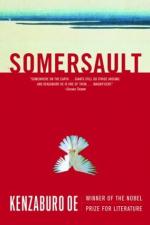|
This section contains 1,057 words (approx. 4 pages at 300 words per page) |

|
SOURCE: Loughman, Celeste. Review of “Seventeen” and “J”: Two Novels, by Kenzaburō Ōe. World Literature Today 71, no. 1 (winter 1997): 229-30.
In the following review, Loughman offers an overview of the major thematic concerns in Seventeen and J.
Ōe Kenzaburō (see WLT 69:1, pp. 5-9) has never made a secret of his affinity with those postwar writers who sought to decentralize the value of the emperor and “to liberate the Japanese from the curse of the emperor system which haunted their minds, even at the subconscious level.” At the same time he understands the collective need for unity expressed in the acceptance of the emperor as the absolute authority. Both these ideas bear on Seventeen (orig. Sebunchin, 1961), the first of two short novels in the volume under review. The time of publication is significant, right after a year of violent demonstrations culminating in the October 1960 assassination of the Socialist Party leader...
|
This section contains 1,057 words (approx. 4 pages at 300 words per page) |

|


